The Chelsea Chop: How and Why You Should Use this Technique


Easily maintain some of your flowering perennials with this simple and actionable plant maintenance tip.
Certain species of taller perennial flowers can occasionally grow quite lanky due to various factors such as overly fertile soil, insufficient or sporadic sunlight, or lack of competition with other plants. These plants may begin to tilt or spill over on fragile stems as they grow upward, causing their flowers to easily topple from their own weight; in other causes like a strong windstorm, taller plants may even break. Fortunately, there is a simple solution: the Chelsea Chop. It’s called the Chelsea Chop because it traditionally takes place around the time of the Chelsea Flower Show, which is usually held in May, typically around the third week of the month in the UK. If applied correctly, this easy technique can help you manage your garden, keep your perennials tidy and healthy, and can even encourage more blooms.


Step-by-step Instructions:
Here’s a step-by-step guide to the Chelsea Chop method:
- Timeline: The Chelsea Chop is performed in mid-spring or early summer, typically at the end of May, and approximately 4-6 weeks before the target plant’s expected bloom. This technique is best done on well-established plants that have reached about ⅓ to ½ of their anticipated full height and have developed robust foliage. Keep in mind that the timing can vary depending on the species and growing region, but aiming for late May is a good standard.
- Tools: Grab a sterilized pair of pruning shears. You’ll want to be sure the shears are clean and sharp to prevent damaging the plants.
- Method: Using the pruning shears, cut across the center of the plant stems, about ½ or ⅓ of the way down from the very top. You can also selectively cut each plant stem by trimming right above the joint where the stem meets a group of leaves.

Benefits of the Chelsea Chop:
This maintenance tip has a wide range of benefits, and can be used on a number of different plants.
Improved Plant Health: By proactively caring for your plant and preventing stem overgrowth and subsequent breakage, you help maintain its overall health, ensuring stronger growth and more blooms.
Increased Blooms: Plants that are pruned back in mid spring will have shorter, stockier growth resulting in fuller blooms, and more flowers. By redirecting resources from growing overly long stems, the perennial plant will put energy towards producing more flowers, resulting in shower plants.
Bushier, Shorter Growth: The early trimming will result in stronger and shorter stalks, creating a neater and more manicured look in your overall garden design.
Plant List:
Here is list of common flowering native perennial plants that can benefit from the Chelsea Chop:
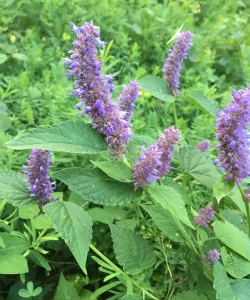
Lavender hyssop has many standout traits that make it a great addition to any native garden. Incredibly long-blooming, its purple flowers bloom from mid-summer through fall. It's a top pollinator plant that attracts droves of native bees. The licorice-scented foliage is edible and deters deer. Lavender hyssop can handle drought once established and is well-behaved in the garden.

Willow aster, is noted for its slender, willow-like leaves and generous clusters of pale blue flowers that bloom profusely in late fall. Its late flowering season provides essential support to pollinators preparing for winter and adds vibrant color to the garden at a time when most other flowers have ceased blooming.
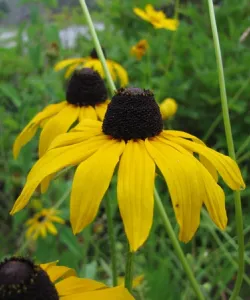
Black-Eyed Susans are a biennial or short-lived perennial. This means it will have impressive flower power in the early years of a planting, a real benefit when other plants take a few more years to get going, but can naturally fade once they do. To keep this short-lived Black-Eyed Susan going in the garden, allow it to self-seed. Attracts butterflies, moths, and bees.

Brown-Eyed Susan feels like a well-kept secret. Its dark brown-centered yellow flowers resemble a miniature Black-Eyed Susan, but the flower abundance is unmatched by most other plants. Brown-Eyed Susan is covered in hundreds of blooms for months through late summer and fall. As you'd expect from a plant with so many flowers, Brown-Eyed Susan can produce a lot of seedlings. Be sure to leave a few, as the plant is short-lived. Foliage can look tired by year's end, but it can be cut back without harming the plant.

Culver's Root is a great architectural plant in the garden. Initially slow growing, it matures into a large plant with star-shaped whorls of leaves topped by long, white flower spikes. The plant resembles a large candelabra when it blooms in early summer and is very attractive to pollinators. It is prone to powdery mildew, a non-serious leaf disease that turns leaves white, so it looks best when tucked behind or within other flowers. The plant is sturdy when grown in the sun, but in a part shade garden it needs staking or can be cut back in early summer to reduce the height.
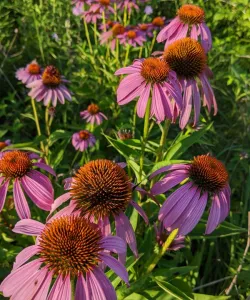
Purple coneflower is a popular plant in native and ornamental gardens alike. Many color and flower morphs are now available, but our plants are the offspring of native prairie inhabitants. This makes them adapted to tough conditions and better for pollinators than cultivars. Spent flowers turn black with seeds, adding winter interest and feeding goldfinches who relish the free meal. Echinacea happily spreads by seed, so remove seedlings in the spring to keep it in check.

Oxeye sunflower has similar flowers to its true sunflower cousins and blooms for around two months. The large blooms are so vibrantly orange-yellow that they seem to glow at the end of an early summer evening. A tall, robust plant that can fill in empty spots or be held in check by removing seedlings or deadheading. Adaptable to most garden situations and can handle moist and drier sites, clay, and poor soils. May develop white or orange spots some years, but this will not harm the plants.

Large-Flowered Penstemon features impressive, and large!, lavender-pink flowers that bloom profusely in late spring to early summer. Its moderate height and upright habit provide structure and visual interest to borders and native plant gardens. The tubular shape of the flowers is perfectly adapted to attract hummingbirds and other pollinators, adding a dynamic element to its garden performance. This Penstemon prefers full sun and well-drained soil, making it an excellent choice for xeric landscapes or rock gardens.
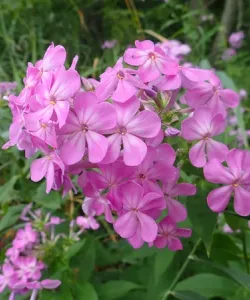
Garden Phlox is a native plant naturally found in woodland clearings and edges, but it's so commonly cultivated that it's earned the name garden phlox. In late summer and early fall, it erupts into airy round clusters of strongly fragrant pink flowers. Garden Phlox attracts hummingbirds and clearwing moths, which are hummingbird mimics (they're also called hummingbird moths for this reason)! These fascinating moths have feathery bodies and fly and hover just like hummingbirds. Garden Phlox can suffer from powdery mildew, which causes white spots on the foliage that do not harm the plant. Phlox can aggressively self-seed and is best paired with other vigorous plants.
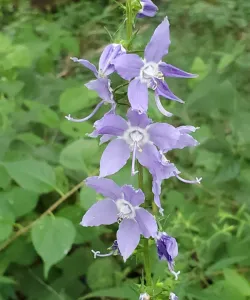
Struggling to find a woodland flower with showy blooms and mid-summer flower power? Well, look no further than Tall Bellflower! It sends up tall stalks of blue to lavender flowers. The flowers resemble wavy stars and can attract hummingbirds. Not picky about site, tall bellflower is adaptable to most soils, including clay. This plant is typically an annual or biennial and will not grow back once it flowers. Clear away mulch around the base of the plant after flowering so that seeds can grow into next year's plants.

Sharply-scented feathery foliage sets common yarrow apart from other plants. This early bloomer is topped by large white flowerheads in early summer and blooms for around two months. The blooms look attractive even when fading at the end of summer. The shallow flowers attract a huge variety of small pollinators. Common yarrow is a robust spreader that can quickly fill in a space. Deadheading and removing new shoots can keep it in check. Flower stems may flop over in rich soils, so stake or cut back flowering stems for a tidier appearance if desired.

Considerations:
The Chelsea Chop is not suitable for all plants, so it's important to verify if your perennial will benefit from this method before using it. Certain shrubs and woody-stemmed plants, like New Jersey Tea (Ceanothus americanus), as well as herbaceous perennials that flower only once per season, such as Columbine (Aquilegia canadensis), Foxglove (Digitalis), Irises (Iris), and Loosestrife (Lythrum alatum), should not be pruned using this technique.

Conclusion:
The Chelsea Chop is a highly effective and straightforward method of maintaining your plants to ensure their health, tidy appearance and encourage more blooms. Many of the My Home Park Garden collections feature plants such as Wild Bergamot, New England Aster and Common Yarrow which particularly benefit from the Chelsea Chop. Use this tip to keep your garden well-maintained and looking beautiful.

Share this article


